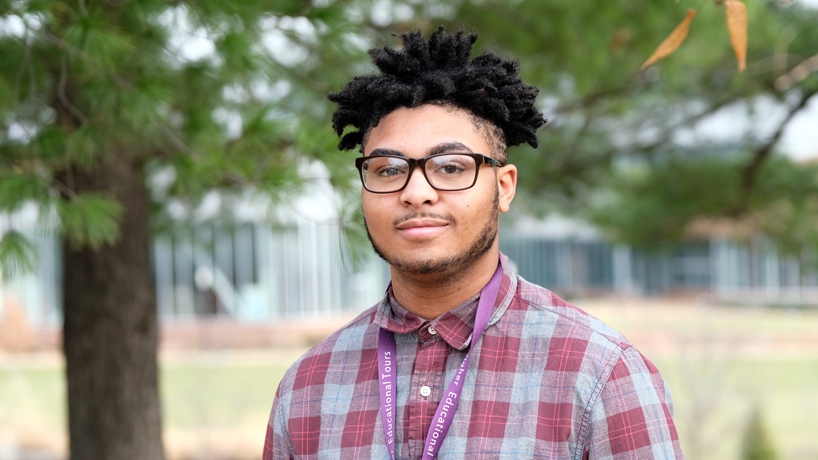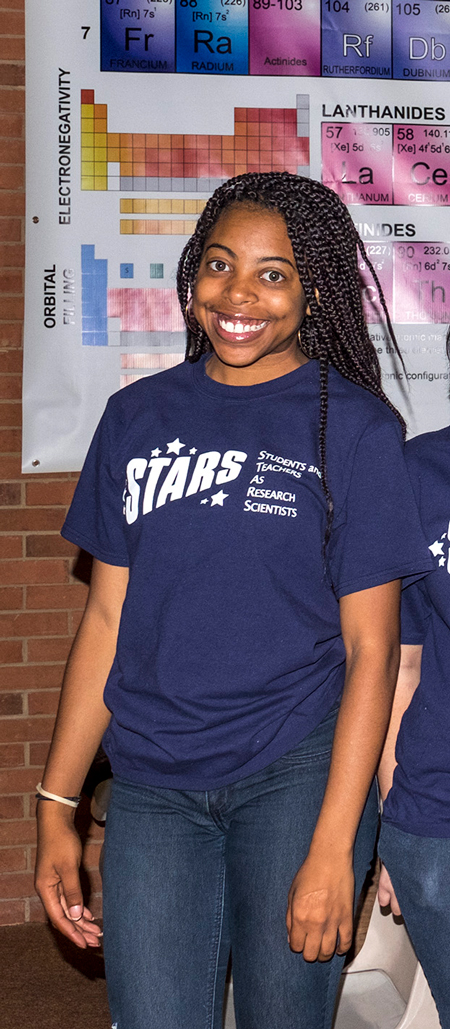
Evan Montgomery’s first experience at UMSL came when he was still a student at Trinity Catholic High School doing research in chemistry and biochemistry Associate Professor Chung Wong’s lab while participating in the summer Research & Engineering Apprenticeship Program. A year and a half later, he’s wrapping up his first college semester with plans to major in computer science. (Photos by August Jennewein)
One can imagine a soon-to-be high school senior hesitating at anything that requires surrendering six weeks of sleeping in during the summer months.
Precious Taylor was no exception when her mother first started pushing her to apply for the Research & Engineering Apprenticeship Program. An initiative of the U.S. Army Educational Outreach Program, REAP aims to place students from groups historically underrepresented and underserved in the fields of science, technology, engineering and math into research apprenticeships at nearby colleges and universities, including the University of Missouri–St. Louis.

Precious Taylor’s experience in the summer STARS program as a student at McCluer High School played a role in her decision to choose UMSL. She’s now midway through her freshman year and planning to major in biology.
“It’s summer,” Taylor remembered telling her mother.
But she acquiesced, completing the online application and drafting a pair of 1,500-word essays required for consideration.
The McCluer High School graduate had no idea when she got accepted into the program that it would be such a transformative experience – not only strengthening her interest in science and exposing her to research, but also influencing her decision on where to continue her academic pursuits after earning her diploma.
Taylor now is one of two students in this year’s freshman class who chose UMSL after doing work on campus through REAP in the summer of 2016. The other is Evan Montgomery, a graduate of Trinity Catholic High School.
Both have plans to pursue STEM degrees, with Taylor expecting to major in biology and Montgomery in computer science.
“A lot of times, even if a student has parents who are in some kind of STEM career, they really don’t know what they do or what their parents are involved in,” said Charles Granger, Curators’ Distinguished Teaching Professor of Biology and Education, who helps lead science education programs at UMSL. “They don’t know what research really is. They don’t know what science really is. They memorize stuff in a book, and REAP gives them an opportunity to really see, ‘Gee, this is something I’d really like to do,’ or ‘Maybe I’d rather write or go into some other area.’ It’s a mechanism by which students can make wise choices based on experience as opposed to what somebody just tells them.”
But Granger believes, more often than not, the experience will help cultivate interest in scientific pursuits.
Students working at UMSL through REAP are integrated with other students involved in the longer-running precollegiate Students and Teachers as Research Scientists program.
“STARS adds a lot more to the program in that there are social activities, networking activities, seminars with prominent researchers, usually from the metropolitan area,” Granger said. “That just adds a little bit of frosting on the cake for these students.”
Like Taylor, Montgomery found it rewarding.
“It was a really cool experience,” Montgomery said. “I got to meet a lot of really intelligent, educated people. We would get these lectures from doctors, from professors at different universities, and they would talk to us about their research. So I learned a lot while I was there, and I broadened my perspective on research and what researchers do.”
He and Taylor also obtained hands-on experience as they worked in Professor Chung Wong’s lab alongside mentors Ananya Mukherjee, a master’s student in the Biochemistry and Biotechnology program, and Qinwei Zhuang, who completed an undergraduate degree in biochemistry and biotechnology last spring.
The research in Wong’s lab involves the development and application of computational methods to study biomolecular structure, dynamics and function. It’s work that can aid the design of bioactive compounds.
Two summers ago, Mukherjee and Zhuang were focused on developing a method for using whole genome sequencing to detect pathogens, and they were writing a computer program to accomplish that goal.
“I have a former PhD student who developed the first generation of the program,” Wong said. “We tried to refine that part a little bit more to improve the detection. Evan and Precious were mainly testing the program.”
They’d run tests with saliva samples to see how well it could detect pathogens.
The biological implications of the research were of interest to Taylor, who has been contemplating a career in medicine ever since she attended a summer science camp and got to work with a pig brain as a high school freshman.
Montgomery was more taken with the programming involved in the project.
His interest in programming grew out of online inquiries into robotics, and he wound up teaching himself more than one programming language as a high school junior.
“When programming, you can really building anything you can think of,” he said. “It’s like this creative space that’s unlimited, so that really interests me.”
Both students drafted extensive research papers detailing their work and their findings and presented them to their peers in STARS at the end of the program.
“I’ve seen their papers,” Granger said. “They learned how to write quite well in a formal sense. The other thing that I really witnessed was they really found it fun to work with the graduate students, someone of nearly their own age, and working in a lab in a collective way as opposed to just doing something on your own.”
Taylor said her conversations with Mukherjee left her with a positive impression of UMSL when it came time to make her college choice.
“She said she really enjoyed campus and that there’s a lot of diversity,” Taylor said. “Everybody’s just with everybody. I think she just tried to give me a good picture.”
By graduating from the REAP/STARS program, both were eligible for UMSL scholarships covering the cost of tuition and fees.
“That’s why I can afford to go to school now,” Montgomery said. “I’m really grateful for that.”
He and Taylor have spent the first semester settling into campus life while living in Oak Hall. They’ve been taking classes to meet general education requirements and looking forward to what’s ahead.















